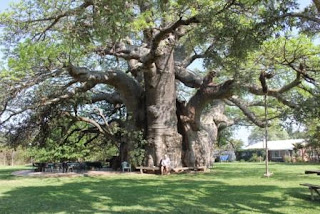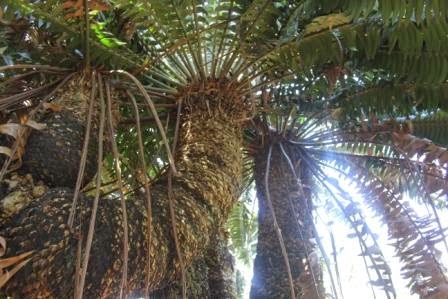Tony and I were in a rush to get away from Nwanedi Game Reserve, and left early on 31st Oct, to travel in to Musina for some shopping - the usual stuff, fresh fruit, veges, wine, beer ........I think we ended up in the wrong end of Musina, we are not part of the demographic the Super Spar supermarket caters to. So we got our stuff done in a big hurry (it was month end) and set course for our next destination - Pafuri River Camp which is 2 kms from the Pafuri gate to Kruger National Park.
We turned up without a reservation on a very hot Friday afternoon, and were
accommodated by Koos and Hannetjie without a problem. Most of their guests use the tented tree houses, and not camping, so space was not an issue. What
a spot this turned out to be - almost completely off the grid - no
electricity, no cell phone signal unless you climbed up to Signal Hill. And what a difference to our previous experience.
For guests, there is a lapa
available - and the bar and shaded swimming pool - temperatures
peaked here in January at over 50 degrees C, so you really need a shaded
pool and bar !
We got our camping spot
in a secluded part of the property, with very own shower (gas) and loo
(flush), set up camp and were ready to relax in this very rustic but
perfect venue.
 |
| The Bathroom |
 |
| The Bedroom |
 |
| And the kitchen |
 |
| Blue Waxbill |
 |
| Violet-backed Starling |
 |
| Collared Sunbird |
 After a couple of lazy days at Pafuri
River Camp, it was time to move on to the meat of our trip - Kruger
National Park ! We entered KNP in the northern end, at the Pafuri Gate
and travelled to the Pafuri Picnic site - a magnet for birders. The picnic site is located on the banks of the Luvhuvhu River, and there are loads of enormous old trees which are home to a huge variety of birds. This is also where we were greeted by a family of ellies having a little paddle in the river while chewing on an obviously tasty dead tree - the mud adds that extra relish !
After a couple of lazy days at Pafuri
River Camp, it was time to move on to the meat of our trip - Kruger
National Park ! We entered KNP in the northern end, at the Pafuri Gate
and travelled to the Pafuri Picnic site - a magnet for birders. The picnic site is located on the banks of the Luvhuvhu River, and there are loads of enormous old trees which are home to a huge variety of birds. This is also where we were greeted by a family of ellies having a little paddle in the river while chewing on an obviously tasty dead tree - the mud adds that extra relish ! At the picnic site, there were also a LOT of birders breakfasting heartily, with all their bird watching gear - the value of which could easily have paid for the upgrades to JZ's Inkandla home, and with money to spare for a couple of extra wives. (Did you know that one of JZ's recent a matrimonial acquisitions is an ex-IBM employee ? )
 But I digress - back to the animals and birds - how lovely is this mommy Nyala and her baby ? This is when I knew we were in for an awesome journey through the park - lots of animals and beautiful birds.
But I digress - back to the animals and birds - how lovely is this mommy Nyala and her baby ? This is when I knew we were in for an awesome journey through the park - lots of animals and beautiful birds. 
The Broad-billed Roller and Grey-headed Bushshrike also featured - again, so many birds that I had never seen!
 Shingwedzi was also the scene of our first lion sighting of the trip. The first few nights after we arrived, we could hear the roar of the lions as we went to sleep. One morning, we realised that the lions had had a successful hunt. Two male lions had killed an adult buffalo on the sandy banks of the Shingwedzi river, and having breakfast by the time we arrived.
Shingwedzi was also the scene of our first lion sighting of the trip. The first few nights after we arrived, we could hear the roar of the lions as we went to sleep. One morning, we realised that the lions had had a successful hunt. Two male lions had killed an adult buffalo on the sandy banks of the Shingwedzi river, and having breakfast by the time we arrived. 
The lions ate their fill, and left to sleep the rest of the day in the shade. Then the next lot moved in - the crocodiles and vultures. Have a look at the picture where one of the crocs has crawled right inside the carcass of the unfortunate buffalo ! Two days later, driving past the same spot, there was no trace at all of the buffalo - not a bone in sight.

And to end this birding episode, with our final bird identification challenge. We found this bird and were unable to identify it - this time of the year there are lots of red herrings (mixing my metaphors now) - there are migrant birds, birds in the breeding feathers, and also a lot of immature or juvenile birds around. So I pondered on this picture for some time before identifying it as a Western Osprey - an uncommon migrant, it says in the gospel according to Roberts.
I am going to publish this post now, and return soon with the animal episode. There has been a long break since the last post - I will refer you to the marvellous service provider who decided that I had used enough data for the month of November, and unless I coughed up exhorbitant amounts of cash, I would have to wait until December to continue the story of our travels. (More details on request - I need to VENT !)































